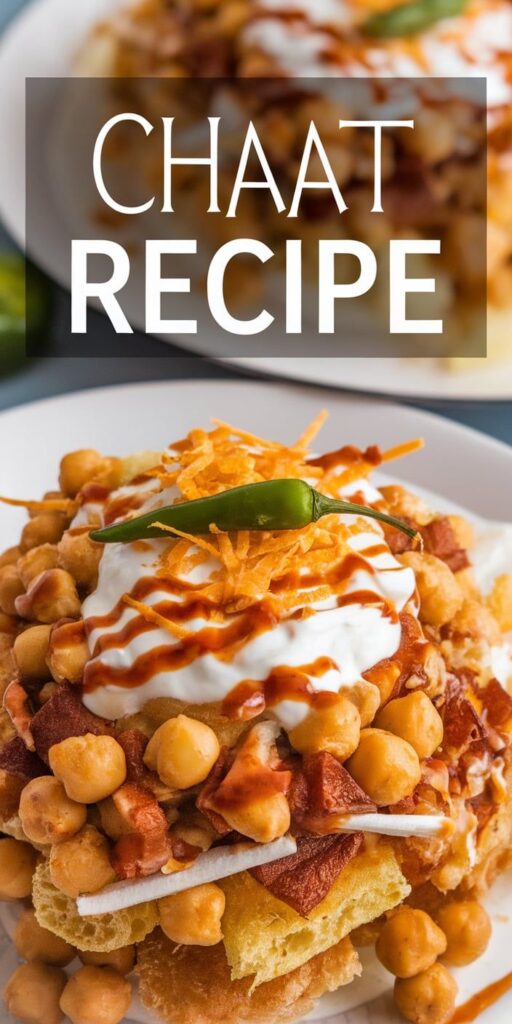Welcome to the delicious world of chaat recipe, a tantalizing Indian street food that will transform your kitchen into a culinary adventure! I’m excited to guide you through creating an authentic homemade chaat that bursts with incredible flavors and textures.
This incredible chaat recipe captures the essence of Indian street food, bringing together a symphony of crispy, tangy, and spicy elements that dance on your taste buds. Each bite tells a story of traditional cooking techniques passed down through generations of passionate food lovers.
From the bustling streets of Mumbai to the vibrant markets of Delhi, chaat represents more than just a snack—it’s a cultural experience. My recipe will help you recreate this beloved dish with simple ingredients and straightforward techniques that make authentic Indian cuisine accessible right in your own home.
Whether you’re a seasoned cook or a curious food enthusiast, this homemade chaat recipe promises to deliver an explosion of flavors that will transport you directly to the street food stalls of India. Get ready to embark on a delightful culinary journey!

What Makes Chaat a Beloved Indian Street Food Sensation
Chaat is more than just a snack – it’s a culinary journey through India’s vibrant street food culture. This delightful cuisine represents a perfect blend of flavors, textures, and nutritional goodness that has captured the hearts of food lovers worldwide.
The chaat history stretches back centuries, rooted in the diverse culinary traditions of the Indian subcontinent. Street vendors and home cooks have perfected these delectable dishes, transforming simple ingredients into extraordinary taste experiences.
Origins of Chaat in Indian Cuisine
Originating in northern India, chaat evolved as a quick, affordable meal for working-class people. The word “chaat” itself means “to lick” in Hindi, reflecting the irresistible flavors that make these dishes so memorable.
Popular Chaat Varieties Across India
- Pani Puri (crispy hollow bread with spicy water)
- Bhel Puri (puffed rice and vegetable mix)
- Aloo Tikki (potato cutlets)
- Sev Puri (crispy crackers with toppings)
- Dahi Puri (yogurt-based chaat)
Health Benefits of Chaat Ingredients
Types of chaat aren’t just delicious – they’re packed with nutritional value. Many chaat recipes incorporate healthy ingredients like:
- Chickpeas (high in protein and fiber)
- Fresh vegetables
- Yogurt (probiotics)
- Spices with anti-inflammatory properties
Healthy chaat options provide a balanced mix of nutrients, making them an excellent choice for those seeking flavorful yet nutritious street food. From Mumbai to Delhi, each region offers its unique twist on these beloved snacks.
Essential Ingredients for the Perfect Chaat Recipe
Creating an authentic chaat requires a carefully curated selection of chaat ingredients that bring explosive flavors and textures to life. The magic of chaat lies in its dynamic mix of crispy, tangy, spicy, and sweet components that dance on your palate.
Let’s explore the key chaat ingredients that transform an ordinary dish into a street food masterpiece:
- Crispy Base Ingredients:
- Papri (crisp flour crackers)
- Puris (deep-fried bread)
- Sev (thin crispy noodles)
- Fresh Produce:
- Diced onions
- Chopped tomatoes
- Fresh cilantro
- Boiled potatoes
Chaat spices are the heart of this beloved street food. My recommended spice blend includes chaat masala, a unique mix that brings tangy and savory notes. Key chaat spices include roasted cumin, black salt, dried mango powder, and red chili powder.
No chaat is complete without its signature chaat chutneys. I recommend preparing three essential chutneys:
- Green mint-coriander chutney
- Sweet tamarind chutney
- Spicy red chutney
Pro tip: Always use fresh ingredients and grind your chaat spices just before preparing to maximize flavor intensity. The right combination of ingredients will transport you straight to the bustling streets of India!
Kitchen Tools and Equipment You’ll Need
Crafting the perfect chaat requires more than just ingredients. The right chaat utensils and preparation tools can transform your cooking experience and elevate the final dish. I’ll guide you through selecting the essential equipment that will make your chaat preparation smooth and enjoyable.
Traditional vs Modern Chaat Preparation Tools
Authentic chaat preparation involves a mix of traditional and contemporary chaat utensils. Traditional tools bring a nostalgic touch, while modern kitchen gadgets offer convenience and efficiency.
- Chakla-belan (rolling pin and board) for making crisp bases
- Stainless steel mixing bowls for ingredient preparation
- Clay griddles for roasting puris
- Electric mixers for quick chutney blending
- Non-stick tawas for crispy papri making
Storage Solutions for Fresh Ingredients
Proper storage is crucial for maintaining the quality of your chaat ingredients. I recommend using airtight containers that keep chutneys, vegetables, and dry ingredients fresh and flavorful.
| Ingredient Type | Recommended Storage Container | Storage Duration |
|---|---|---|
| Fresh Chutneys | Glass jars with tight lids | 3-4 days refrigerated |
| Chopped Vegetables | Plastic containers with drain holes | 1-2 days |
| Dry Ingredients | Airtight ceramic containers | 2-3 weeks |
Chaat Serving Accessories
Presentation matters in chaat serving. Invest in small ceramic bowls, colorful plates, and traditional banana leaf platters to create an authentic street food experience right at home.
- Stainless steel serving spoons
- Colorful ceramic bowls
- Banana leaf plates
- Small garnishing tools
Preparing the Crispy Base: Papri and Puris
Creating the perfect chaat base starts with mastering homemade papri and puris. These crispy foundations are essential for an authentic chaat experience. I’ll walk you through the process of making these delightful components from scratch, ensuring your chaat recipe stands out.
For homemade papri, you’ll need a few simple ingredients:
- All-purpose flour
- Semolina (for extra crispiness)
- Salt
- Vegetable oil for frying
The puri recipe requires careful attention to detail. I recommend using a mixture of wheat and all-purpose flour to achieve the perfect texture. Kneading the dough thoroughly helps create those signature crispy edges that make chaat so irresistible.
Key steps for making the ideal chaat base include:
- Preparing a firm, smooth dough
- Rolling out thin, even circles
- Ensuring proper oil temperature for frying
- Draining excess oil on paper towels
For those short on time, store-bought alternatives work well. I suggest checking local Indian grocery stores for ready-made papri and puris. Still, nothing beats the satisfaction of creating your own crispy chaat base from scratch.
Pro tip: Keep your homemade papri and puris in an airtight container to maintain their crunchiness. They’ll stay fresh for several days, making meal prep even easier.
Creating the Perfect Sweet and Tangy Chutneys
Chaat chutney recipes are the heart and soul of authentic Indian street food. These vibrant homemade chutneys transform simple ingredients into a flavor explosion that defines the essence of chaat. I’ll share three classic Indian chutney recipes that will elevate your culinary experience.
The magic of chaat lies in its diverse and bold flavor profiles. Each chutney brings a unique dimension to the dish, creating a perfect balance of sweet, tangy, and spicy notes.
Green Mint-Coriander Chutney
This fresh and zesty chutney is a staple in traditional chaat recipes. Here’s what you’ll need:
- 2 cups fresh coriander leaves
- 1 cup fresh mint leaves
- 2-3 green chilies
- 1 inch ginger
- 2 tablespoons lemon juice
- Salt to taste
Blend all ingredients until smooth. The result is a vibrant green chutney that adds a refreshing kick to your homemade chutneys.
Sweet Tamarind Chutney
This rich, sweet-and-sour chutney is essential for authentic chaat flavors:
- 1 cup tamarind pulp
- 1/2 cup jaggery
- 1 teaspoon cumin powder
- 1/2 teaspoon red chili powder
- Salt to taste
Simmer ingredients until they reach a thick, syrupy consistency. This Indian chutney adds depth and sweetness to your chaat.
Spicy Red Chutney
For those who love heat, this chutney brings the fire:
- 6-8 dried red chilies
- 4 garlic cloves
- 2 tablespoons vinegar
- Salt to taste
Soak chilies, blend with other ingredients. This powerful chutney adds a spicy punch to your chaat chutney recipes.
Step-by-Step Chaat Recipe
Learning how to make chaat is an exciting culinary adventure that brings the vibrant flavors of Indian street food right to your kitchen. I’ll guide you through the chaat assembly process with easy-to-follow recipe steps that will help you create an authentic and delicious dish.
Let’s break down the chaat recipe steps into simple, manageable stages:
- Prepare the crispy base:
- Arrange papri or puris on a serving plate
- Ensure the base is evenly spread
- Layer your chutneys:
- Drizzle green mint-coriander chutney
- Add sweet tamarind sauce
- Sprinkle spicy red chutney
- Add protein and vegetables:
- Sprinkle boiled potatoes
- Add chickpeas or moong sprouts
- Include chopped onions
- Finish with toppings:
- Sprinkle sev (crunchy noodles)
- Add fresh cilantro
- Dust with chaat masala
The key to perfect chaat is balancing textures and flavors. Each layer should complement the others, creating a harmonious blend of crispy, tangy, and spicy elements that dance on your palate.
Pro tip: Serve immediately after assembly to maintain the crispy texture of the base. Enjoy your homemade chaat that rivals any street food vendor!
Customization Options and Variations
Chaat is a culinary playground that invites creativity and personal expression. The beauty of these delightful street food recipes lies in their incredible flexibility to customize chaat according to individual preferences and dietary needs.
Exploring chaat variations allows you to transform a classic recipe into a unique culinary experience. Let me share some exciting ways to make your chaat truly special.
Vegetarian Adaptations
Vegetarian chaat recipes are incredibly simple to create. You can easily swap protein ingredients with plant-based alternatives:
- Replace yogurt with coconut or almond-based yogurt
- Use tofu or chickpeas as protein substitutes
- Incorporate roasted vegetables for extra nutrition
Spice Level Adjustments
Regional chaat recipes offer diverse spice profiles. Adjust the heat to suit your taste by:
- Reducing green chili quantities
- Using mild pepper varieties
- Adding cooling elements like yogurt or cucumber
Regional Twists
Different regions in India boast unique chaat variations that reflect local ingredients and cooking styles. Experiment with regional techniques to discover new flavor combinations and culinary traditions.
Tips for Storing and Serving Your Homemade Chaat
Preparing chaat for a party can be a delightful culinary adventure. When it comes to chaat storage, I recommend keeping the crispy components separate from wet ingredients. Store papri and puris in an airtight container at room temperature to maintain their crunch. Chutneys can be refrigerated in sealed glass jars for up to a week, which makes preparing for your chaat party much easier.
Serving chaat is all about timing and presentation. I suggest assembling the dish just before serving to prevent soggy ingredients. Keep your components ready in separate bowls, allowing guests to customize their own chaat experience. Pro tip: warm your serving plates slightly to help maintain the ideal temperature for your delicious street food creation.
Chaat party ideas often revolve around interactive food stations. I love setting up a DIY chaat bar where friends can mix and match ingredients. Provide small plates, fresh herbs, and extra chutneys so everyone can create their perfect bite. Remember that authentic chaat is best enjoyed immediately, so encourage your guests to assemble and eat quickly to enjoy the maximum flavor and texture.
Leftovers can be tricky with chaat. While the individual components store well, the assembled dish loses its magic quickly. I recommend making just enough to enjoy in one sitting, ensuring every guest gets a fresh, crispy, and flavorful experience that captures the true essence of this beloved Indian street food.



